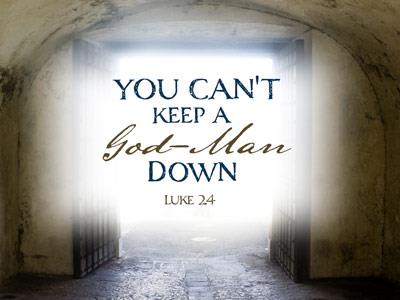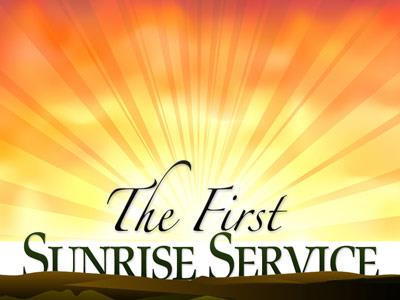-
Resurrection: A Theology Of Hope
Contributed by Matthew Kratz on Apr 10, 2020 (message contributor)
Summary: In Mark 16:1-7, we see the two elements of 1) The Grief (Mark 16:1–3) and 2) The Glory (Mark 16:4–7) of God the Father's Resurrection of God the Son bringing "A Theology of Hope"
Mark 16:1-7 [16:1] When the Sabbath was past, Mary Magdalene and Mary the mother of James and Salome bought spices, so that they might go and anoint him. [2] And very early on the first day of the week, when the sun had risen, they went to the tomb. [3] And they were saying to one another, "Who will roll away the stone for us from the entrance of the tomb?" [4] And looking up, they saw that the stone had been rolled back--it was very large. [5] And entering the tomb, they saw a young man sitting on the right side, dressed in a white robe, and they were alarmed. [6] And he said to them, "Do not be alarmed. You seek Jesus of Nazareth, who was crucified. He has risen; he is not here. See the place where they laid him. [7] But go, tell his disciples and Peter that he is going before you to Galilee. There you will see him, just as he told you." (ESV)
There are many different reasons why you may have tuned in to this online worship service today. For some, they were basically told to by their parents or spouses. Some tuned in because to have questions answered, others to just find out what the whole thing is about. There are some that are watching out of genuine reverence and worship of God while others, because of duty.
There was probably a mix these reasons why a group of three women set out early on that first Resurrection Sunday to see Jesus. Not really understanding what was going on, they set out with anointing items expecting to see their dead leader. Beyond the fear and withdrawal of Jesus' other followers, these women in a sense of duty and love came to see Jesus one last time.
Your reason to be participating in this today will say a lot about you. We do many things in life for many different reasons. When we worship together we begin to see life from a different perspective. We come with burdens and praises. We come with questions and reflections on truth. When we come to meet Jesus together, the events of our lives from the triumphs to the tragedies begin to unfold with greater clarity. God the Father's Resurrection of God the Son is a message of hope. Although suffering and death seem like defeat, Christ triumphed over the grave, providing the one and only sufficient sacrifice for sin shown acceptable by the Father raising His Son from the dead. We who place our faith in a resurrected savior, have hope of not only God's providential control in this life, but assurance of life eternal.
In Mark 16:1-7, we see the two elements of 1) The Grief (Mark 16:1–3) and 2) The Glory (Mark 16:4–7) of God the Father's Resurrection of God the Son bringing "A Theology of Hope"
The Resurrection of Jesus Christ is "A Theology of Hope" as first seen through:
1) The Grief (Mark 16:1–3)
Mark 16:1-3 [16:1] When the Sabbath was past, Mary Magdalene and Mary the mother of James and Salome bought spices, so that they might go and anoint him. [2] And very early on the first day of the week, when the sun had risen, they went to the tomb. [3] And they were saying to one another, "Who will roll away the stone for us from the entrance of the tomb?" (ESV)
Mark 16:1 begins that the sabbath was over. The Jews marked their days at sundown rather than midnight, so the Sabbath ended on Saturday evening around 6:00 P.M. But Mark’s statement, that it was past/over, does much more than simply convey the timing of Jesus’ resurrection (cf. Mark 16:2). It also stands as a theological marker indicating that the Sabbath itself was now obsolete because a new era of redemptive history had begun. No Sabbath observance has been divinely authorized or mandated since the resurrection (cf. Col. 2:16–17). Like the Passover, which ended when Jesus instituted the Lord’s Supper as the new memorial feast commemorating His death (Mark 14:22–25), the Sabbath was replaced by the Lord’s Day to commemorate His resurrection every first day of the week (cf. Acts 20:7; 1 Cor. 16:2; Rev. 1:10). (MacArthur, J. (2015). Mark 9–16 (p. 398). Chicago, IL: Moody Publishers.)
For Orthodox Jews, from sunset on Friday to sunset on Saturday, the second of the three days, there is no movement and activity at all. Jesus’ body rests in the tomb, and the survivors are—the reader presumes—keeping the sabbath. Readers unfamiliar with the Jewish belief that the spirit does not leave the body completely until after three days, are aware that with the third day drawing near the story is building up to a dramatic climax. Both readers and disciples have heard Jesus say that three days after being killed he will rise again (Mk. 8:31; 9:31; 10:34), and also that after his resurrection he will again go ahead of the disciples in Galilee (14:28) (van Iersel, B. M. F. (2004). Vol. 164: Mark: A reader-response commentary. Journal for the Study of the New Testament. (493). London; New York: T&T Clark).

 Sermon Central
Sermon Central



